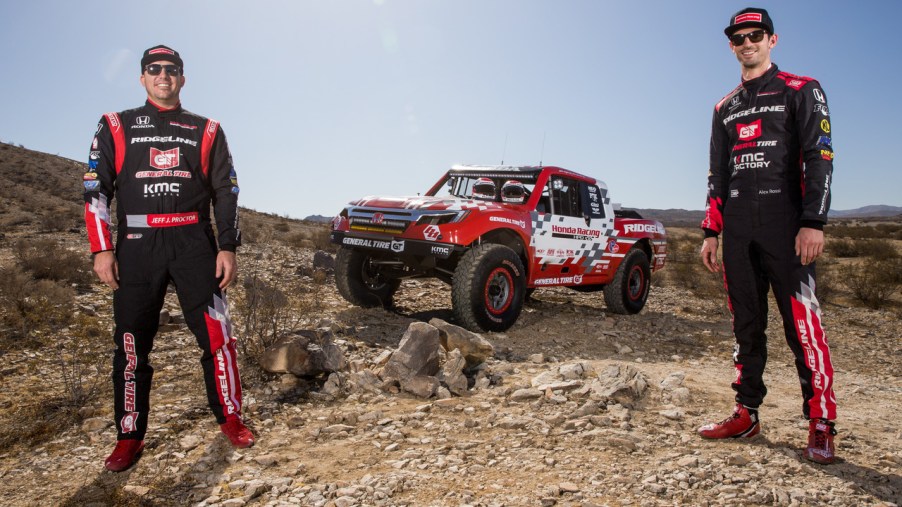
Behind the Wheel: Driving the Honda Ridgeline Baja Race Truck
In everyday driving, vigilance is important. We know to look ahead to see what’s coming. Is there a wreck up ahead? A pack of deer that could leap across the road at any minute?
But we also try to check what’s right in front of us. What if you’re going pretty fast on the highway and you run into big valleys and hills?
According to the team at Motor Trend, you’re ready for anything in the Honda Ridgeline Baja Race Truck. Team member Scott Evans took it for a spin and had plenty to say about the experience.
Side-seat madness
The dirt and sand “road” would test the best of off-road-ready vehicles. Evans mentioned that the RAM 1500 Laramie 4×4 he drove in Honda’s Off-Road Racing Team’s Mojave Desert challenge would have to crawl slowly along it to prevent damage to the front end, even on the “smooth” sections. He said he’d be afraid to go over 40 mph.
The Ridgeline Baja Race Truck makes one apprehensive just leaving the pit area. The easy bobbing motion of it as it moves isn’t what people are accustomed to with standard vehicles. But, when you see it at full pace, Evans says it makes sense.
Typical Baja trucks like the Honda’s Class 7 Ridgeline have two to three feet of suspension travel. It allows them to bounce along the terrain they travel on. With that suspension, the truck’s wheels only partially drop into the holes it encounters and easily bounce up again. The body and chassis float along the top all the while without interruption. While it seems impossible, the suspension can take such abuse for several hundred miles.
From the passenger seat, Evans describes madness. He could see the valleys and dips straight ahead, each looking like an inevitable crash. For someone used to a conventional car, each obstacle looked like impending doom. Hitting each one, he said, was like hitting a pothole that hasn’t been patched yet.
Driven by Indy 500 winner Alexander Rossi, Evans describes riding along at 90 mph and how it’s both thrilling and intimidating. The experienced driver got the vehicle up to 115 mph, going airborne at times.
In the driver’s seat
When it was Evans’ turn behind the wheel, he commented on the automatic transmission pretty much being in first gear upon starting the engine. And the engine registers a good 550 or more horsepower in the rear-wheel-drive vehicle.
He shifted to second gear and picked up speed, looking at the road ahead. He explained how driving the Baja truck over the rough terrain was different from standard highway driving.
Focusing on the holes and hills right in front of you would cause you to wreck. Focusing on the road ahead prevented him from trying to correct in crisis mode at every obstacle he encountered. He explained that you just needed to remember you have a suspension that can handle anything you encounter.
Evans explained that the truck was at home skipping over the terrain as opposed to digging into it. Slowing down wasn’t what you wanted to do. He discovered a light touch on the steering wheel worked best as the truck moved around under him. He found not trying to correct each thing he encountered got him through just fine. Overcorrecting could easily lead to a rollover.
He found executing turns to be tricky. The Ridgeline’s body had more roll than a street truck. Turning the wheel made him feel as if he were going to roll the vehicle because it leans over a good deal. Yet it stops and sets in a way that he had to get accustomed to. He said turning too hard could cause a roll.
While he claims he used the brakes little, he said slowing the vehicle was the easiest part of his experience. Evans said the aerodynamics, engine braking, and terrain slowed the truck fast as did moving the shifter forward for a downshift. Tight corners, he said, were the only time you wanted to use momentum before braking as late as possible.
Evans said driving the Honda Ridgeline Baja Race Truck was a lot like driving the Yamaha YXZ, Polaris RZR, or Honda Talon, just faster. He claimed the speed was addictive and the ride a lot less punishing. While those vehicles feel fast, after experiencing the Ridgeline Baja, getting out and running foot would seem faster.
The verdict
Honda’s Ridgeline Baja Rack Truck offers a tube frame with fiberglass panels as covering. There are a few distinctive Ridgeline styling elements along with an independent front and live-axle rear suspension setup. Despite its configuration, it’s still a Ridgeline with the same block and heads used in a production Ridgeline. The engine is a 3.5-liter SOHC V6 with racing parts added and a pair of turbos added.
Evans described his experience driving the Honda Ridgeline Baja Race Truck as “life-altering.” It’s earned a class win or a podium finish in every competition, including class wins at the Baja 500 and 1000. He claims the truck lives up to the hype saying it’s real and he “needs one.”


